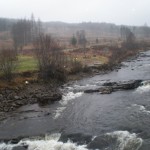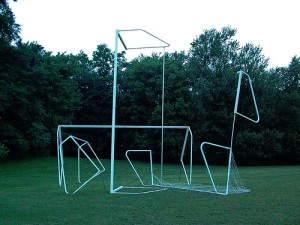Gotta love travelling.
Different outlook = different outlook!
I don’t think I want to leave this place 🙂
The best laid plans of a bracing walk through the wilds of Scotland with John were overthrown by the weather, and so we spent a great few hours in the cosy surrounds of the elegant lounge room at the Bridge of Orchy Hotel (in the west central Highlands of Argyll).
 We chatted our way through most of the ills facing education today, planned and plotted how to fix the world and made our way back to what we were all up to and planning for the next year or so.
We chatted our way through most of the ills facing education today, planned and plotted how to fix the world and made our way back to what we were all up to and planning for the next year or so.
In The World According to Three Educators by a Fire, this is what we came up with:
Know your goals as you set out.
Take a steady approach, but always with your goals in mind.
Be prepared for serendipitous events, embrace them, use them and learn from them.
Allow students to lead their learning – support, encourage and celebrate learning as it happens.
Need to backward plan at times to enable a more open and exploratory type of learning to take place.
 Thanks John, with your knowledge and understanding of students, learning and ICT I know you will continue to make a positive impact on learning in North Lanarkshire schools.
Thanks John, with your knowledge and understanding of students, learning and ICT I know you will continue to make a positive impact on learning in North Lanarkshire schools.
Do we “tick the boxes” or teach in a creative, child-centred and thought provoking way where students and teachers are given permission to learn and discover together, in a partnership of learners?
Do we encourage young teachers (all teachers?) to engage with their students, form relationships and learn together using new technologies and applications to enhance learning and relevance?
Do we support the exciting and innovative, scaffolding the teacher (like we do the students) so that they have freedom within a framework?
Quite simply, I think we do, I think we have to.
We owe our students and teachers to encourage and advocate for the inspiring, the innovative, the exciting and the relevant.
Do we?
Can we?
Will we?
Snug and warm in a tiny café off the Royal Mile, we met up with the Adventure Author team: Judy, Cathrin and Keiron, to catch up and to discover what everyone had been up to since we last met.
The Adventure Author Project has finished, and the intrepid three are moving on so it was a good time to recap and talk about what they had found out and where they might go next.
Judy shared some of the newer features of the Adventure Author software:
1. Comment Cards – which allow comments to be made and shared between students and the teacher
2. Evaluation Page – specific criteria to be evaluated
– star rating
– attach evidence option
3. To Do List – to keep track of what has been done and what needs to be done next
And we discussed how they have been used by students how they might be used by teachers to scaffold and support writing (as well as game making).
Judy and her team insist that students are at the centre of their learning – that students need to drive their own learning, work together to explore and discover and then share what they have found out.
This approach seems to give students the permission to take responsibility for their actions/plans, gives them the structures to develop their learning around and the confidence, time and expectation that they will then share and evaluate what they have done or discovered.
We discussed how this approach works in various settings (with undergraduates and Primary students) and all felt that an unexpected bonus was the creative way students could (and did) respond to the challenge of being in control of the what and how of their learning.
As always, some wonderful and thought provoking ideas about creativity ensued – eg does one create and then find a purpose for the creation or does one create for a purpose or does one create because they can?????? (Maybe all at different times).
Thanks team for a great afternoon and night of interesting, provoking and thoughtful discussions and sharing. Looking forward to hooking up with something new in the not-too-distant-future.
I have been using games in my classroom for nearly two years now and have been constantly surprised at the excitement, success and achievements of my students in this time. My students’ writing has especially been of interest to me and I have thought long and hard about how and why using games elicits such wonderful responses.
I first used PS2 game back stories as models (in 2006) for my students to write their own stories with surprising results. I then moved on to the very different and beautiful Samorost and Samorost 2 games as stimulus (2007) with again, wonderful results.
Using historical stories to build their own games, and write the back stories (also 2007) encouraged the students to come up with interesting and well thought out ideas.
Most recently I used Mario and Sonic at the Olympics as stimulus for writing poetry, which also yielded positive results.
Lots of different games, from internet based to COTS, yet all had great impact on the quality of the writing produced by my students. Why? How?
Well, in a coming together of ideas and professional learning over this time, I’ve read “Out of Our Minds. Learning to be Creative” by Sir Ken Robinson. So much of what he said made sense to me and led me to this post of thoughts as to why using games with my Primary aged students helps their writing.
The use of the games allows for and promotes creativity!
Robinson refers to creativity as
most of these aspects can be linked to the use of computer games within my class. Perhaps my students are creatively learning – is that it?
I would love to know what you think 🙂
Collaborative nature of using games with the whole class on the big screen enables all to participate at whatever level they are comfortable with: amateurs, newbies, competents all have some stake in the game; all have important comments and views to share.
Newbies are seeing things for the first time – they can often share new perspectives that competents and amateurs hadn’t thought about.
Newbies ask questions that competents and amateurs can try to answer – by articulating what they know and teaching others the whys and hows of the game, strategies, language and information within the game can be shared.
Sharing of knowledge, ideas, vocabulary and the “piggy backing” of thoughts helps to grow new ideas and thoughts. Robinson says that we make sense of the world by trying on ideas for size. Shared vocab, shared imagery – this belongs to all of us. Sharing of the language involved provides models and scaffolds that support all learners – ESL, language disordered, struggling and advanced users of English.
Sometimes the class starts with a common sentence, and everyone builds that sentence into something new. New vocab has meaning; new ways of saying something are shared and modelled. The language belongs to all of us, it gets better and more descriptive the more we use it and mould it to what we want to say.
Striving for more – students push themselves to get better/ be better. They work and think hard together, as a class, to achieve, to make the work stronger, the images clearer and the language richer. Students enjoy the notice, the acknowledgement of their classmates when they come up with a great idea, word, image or phrase.
During the game and the learning sessions, students are working for the common exploration of the game, the theme, the topic; they are working together to explore and imagine. There are no grades, no external reinforcement, just a sense of accomplishment and pride in what they can do. Pushing past what they thought was their best, to speaking, writing or thinking something that is new, improved and satisfying.
A community. My students are not isolated – it’s not them and a blank page – everyone starts together through talking and suggesting. The game provides a shared beginning with lots of “jumping off” points to get them started and on their way.
The oral aspect is vitally important for all students. Trying out ideas, and how they sound in English, and how they might best be written is hard for my ESL students- many of whom don’t yet have a strong idea of exactly how English should sound.
Acceptance of their ideas, providing alternative ways of saying the same thing, playing around with the language in a supportive way builds up the sense of community – everyone has something to offer.
Drama is a fantastic way to tease out new ideas and concepts especially when students are struggling with finding the English words for what they are seeing. Even advanced English speakers are able to develop their vocabulary through dramatic representation of what they are seeing and doing on the screen, in the game.
Students are motivated to try new ideas, new imagery, new ways of approaching writing in a supportive, yet exciting environment. My students are in a familiar domain (computer games) and can relax into the rigorous school domain where they are expected to write (in English) about unfamiliar topics, events and experiences. Their motivation seems to run deeper than simply playing computer games in school. They are being asked to do more than just play the game – they are being asked to think, to respond, to create, to move past the actual game in front of them, to record and deliver their ideas in new and interesting language.
Safe risks where students are encouraged to take risks and realize that to fail (some ideas they have will be better than others) is an important part of learning. Sometimes the flow of ideas and talking is so fast that it’s hard to get what you want down, but in this environment my students can see that their writing is not permanent – they can change it, add to it, re-arrange it, and if they really don’t like it cross it out or leave it and move on. Robinson beleives that creativity involves a dynamic interplay between generating ideas and making judgements about them. We get more ideas, and better ideas through taking these safe risks in a supportive atmosphere.
How different this is from the prolonged agony of no ideas, an empty white page and 20 minutes to write something, anything, at all. When all there was time for was to write down the first thing that came into your head, and it stayed there on the page mocking you (but it really didn’t matter because you didn’t need to read it again anyway. The teacher was the only one who read your work!).
The excitement and noise of ideas bursting forth, of being re-written and re-worked, of being tried out and accepted or laughed at and rejected, only to be picked up again later and turned into something useful. Or the quiet of pencils scratching workbooks, students mumbling sentences under their breath and a sigh of success as their writing works out and they finish off with a flourish and a grin J
I don’t know ………, I’m scratching for answers or insights into why gaming offers such impetus to my students. Is it the creative aspects of the tasks that appeal and resonate with the students? I do know that using computer games has impacted strongly and positively on my classroom over the last two years. Hopefully I’ll find out more (answers or questions – I’m not sure) when in Scotland and England early next year!
I was feeling very guilty … I was letting my Year 4’s down … I had planned a series of activities to “do” with the Year 4’s (ages 8-9) that tied in with the Dolphin Island game, but I hadn’t had time to do more than explain some of the ideas of what we could do.
When I finally called them all together to get “started” I had no takers – they were all otherwise engaged!
Four students were bunkered down on the pillows totally absorbed in playing the game. Someone called “TIME” and the games were passed on to the next player, the groupings moved around and the next lot of kids were soon quickly drawn into the game as well.
A little group were huddled around the DOCs (Dear Old Computers or Dead, Old Computers depending on the current state of operability!) reading and typing from their writing notebooks information about dolphins onto the class wiki.
One little person was flicking through non-fiction texts looking for creatures that were in the game. Winson was looking up more facts about orcas on the internet – and pushing his and my current knowledge about the relationship between dolphins and orcas.
I didn’t want to interrupt so left them till later.
However…… later on ….
I’m afraid that my Year 4’s are just too busy
to “do” my activities.
Isn’t it great 🙂

I have always got my class to set goals at the beginning of each term or semester. I think that this is one small way that my students can learn to grow as effective and more independent learners. I think that setting goals for the term or semester can help my students organise themselves and “learn to learn”.
Goal setting is important
Some times and classes are more successful than others –
Students gain much from articulating their goals and their targets to reach their goals, and in my experience they need to
write it down
mark it off
check it
compare
look for “personal bests”
celebrate reaching targets
think about the goal
affirm themselves
Student goal setting needs to be open, students need to be accountable, they need to be able “see” and “say” their goals and targets.
You’ll find some useful proformas to adapt and use this semester, and a SMART site might help.
Now, in the spirit of keeping on, we will track where we want to go this semester ….
Dean Shareski recently posted about blogs that succeed, and listed five simple ways he’s discovered to help students and teachers blog successfully:
Blogging is mostly about reading
To make a friend you have to be a friend
It’s personal
Hyperlink
Get graphical
I’ve been struggling a bit lately with finding the impetus to write, and I think its because I’ve over planned the whole “story” too much.
I’ve also been doing lots and lots of reading but not responding in any way – just thinking “Yeah, I agree with that!” and moving on to the next post.
Maybe I need to explore graphical ways of communicating – try out some new applications so I can use them/show them in class as well.
I shared Dean’s suggestions with my class and they had a lively discussion about the ideas raised – we’ve all agreed to get down and serious about improving our blogging this term, just you wait and see if we don’t 🙂
An exciting day spent listening to some of Australia’s premier edubloggers:
plus the blog guru himself – Will Richardson!
A great opportunity for our school group to hear and see first hand how the web is transforming learning and teaching, and to consider why we must embrace and work with web2.0 to keep learning in schools relevant – for our students and for ourselves.
Co-create
Share
Empower
Transform
Question
Networks
Deep understandings
Change
Improve
……….. just a few things on our “to do” list when we are back at school…………
Here is a mind-map I jotted out at the event, a way of sorting the information/thoughts/opinions from the esteemed presenters 🙂